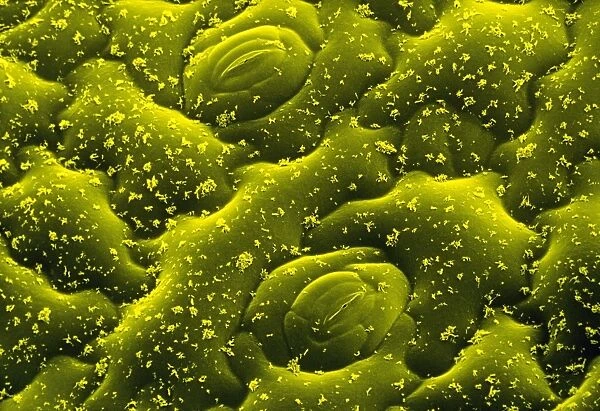Leaf surface of succulent plant
![]()

Wall Art and Photo Gifts from Science Photo Library
Leaf surface of succulent plant
False colour scanning electron micrograph of leaf surface of a succulent Kalanchoe blossfeldiana, a house plant. Featured are two closed stomata nestled among the epidermal cells.The stomata, pores in the leaf surface, regulate gaseous exchange with the environment. Like many succulents, this one has a Crassulacean acid metabolism, an adaptation to hot, arid conditions. The stomata are open at night (reversal of normal), absorbing carbon dioxide & converting it to an organic acid. They close during the day, but continue the process of photosynthesis as usual, using the carbon dioxide collected at night. The flecks on the surface are wax. Mag: X86 at 35mm. Original is BW print B745/070
Science Photo Library features Science and Medical images including photos and illustrations
Media ID 6290707
© DR JEREMY BURGESS/SCIENCE PHOTO LIBRARY
EDITORS COMMENTS
This print showcases the intricate leaf surface of a succulent Kalanchoe blossfeldiana, a popular house plant. The false color scanning electron micrograph reveals two closed stomata nestled among the epidermal cells, which are responsible for regulating gaseous exchange with the environment. What makes this succulent unique is its Crassulacean acid metabolism, an adaptation to thrive in hot and arid conditions. Unlike most plants that open their stomata during the day to absorb carbon dioxide, this succulent reverses that process. Its stomata open at night, absorbing carbon dioxide and converting it into organic acid. During daylight hours, while the stomata remain closed to prevent water loss, photosynthesis continues as usual using the stored carbon dioxide from the previous night. This clever mechanism allows these resilient plants to survive in harsh environments. The flecks visible on the leaf's surface are wax deposits that serve as a protective layer against excessive evaporation and potential damage from intense sunlight. Captured at 86 times magnification with a 35mm lens, this black-and-white print (B745/070) by Science Photo Library beautifully illustrates nature's ingenuity in adapting to challenging surroundings. It offers us a glimpse into the fascinating world of botany and highlights how even seemingly small organisms can possess remarkable survival strategies.
MADE IN THE USA
Safe Shipping with 30 Day Money Back Guarantee
FREE PERSONALISATION*
We are proud to offer a range of customisation features including Personalised Captions, Color Filters and Picture Zoom Tools
SECURE PAYMENTS
We happily accept a wide range of payment options so you can pay for the things you need in the way that is most convenient for you
* Options may vary by product and licensing agreement. Zoomed Pictures can be adjusted in the Cart.




